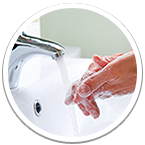Interpretation of pneumococcal vaccine response (conjugate)
The pneumococcal conjugate vaccine was included in the National Immunization Program in the autumn of 2010. All children born after 1 June 2010 are entitled to receiving the Synflorix vaccine, which provides protection against 10 different pneumococcal strains. The vaccinations are given at 3, 5 and 12 months.
Those who have received stem cell transplantation are also protected against pneumococcal diseases. The Prevenar13 agent is used for their vaccinations.
Synflorix and Prevenar13 can also be used to vaccinate other age groups. Those at least five-year-olds only need one dose.
Issues to consider when taking samples
The antibody response to a PCV vaccine develops within 4 weeks of vaccination. For this reason, a serum sample should be extracted no earlier than 4 weeks after vaccination, but no later than within 2 months.
Interpretation of pneumococcal conjugate vaccine response
The interpretation of vaccine responses is limited by the absence of a determined antibody concentration sufficient to protect the individual against pneumococcal diseases. A previous infection and nasopharyngeal carrier state also produce antibodies for pneumococcal polysaccharides.
By comparing antibody concentrations before and after vaccination, it is possible to assess whether the person has formed an immune response to the types of pneumococcal serotypes contained in the vaccine.
In the assessment of the vaccine response, the response can be considered to be normal, if the antibody concentrations show, for example, a double increase for all the vaccine serotypes examined [1] or a fourfold increase for at least half of the serotypes [2].
The World Health Organization (WHO) has set an antibody threshold of 0.35 µg/mL [3]. This value is used in the vaccine licensing process to assess immunogenicity at population level. The threshold is based on a meta-analysis of the results of three vaccine studies [4].
The threshold set by the WHO cannot be used when assessing whether a person is protected against pneumococcal diseases. This is due to the fact that the antibody concentration that protects against these diseases may vary considerably depending on the clinical picture, serotype [5] and the age of the vaccinate person.
References
1. Pasiarski M, Rolinski J, Grywalska E, Stelmach-Goldys A, Korona-Glowniak I, Gozdz S, Hus I, Malm A. Antibody and plasmablast response to 13-valent pneumococcal conjugate vaccine in chronic lymphocytic leukemia patients-preliminary report. PLoS One. 2014 Dec 15;9(12):e114966§
2. King JC Jr, Vink PE, Farley JJ, Smilie M, Parks M, Lichenstein R. Safety and Immunogenicity of three doses of a five-valent pneumococcal conjugate vaccine in children younger than two years with and without human immunodeficiency virus infection. Pediatrics. 1997;99(4):575–80
3. World Health Organization. Recommendations to assure the quality, safety and efficacy of pneumococcal conjugate vaccines-proposed replacement of TRS 927, Annex 2, ECBS, 19 to 23 October 2009
4. Siber GR, Chang I, Baker S, Fernsten P, O'Brien KL, Santosham M, Klugman KP, Madhi SA, Paradiso P, Kohberger R. Estimating the protective concentration of anti-pneumococcal capsular polysaccharide antibodies. Vaccine. 2007 May 10;25(19):3816–26.
5. Andrews NJ, Waight PA, Burbidge P, Pearce E, Roalfe L, Zancolli M, Slack M, Ladhani SN, Miller E, Goldblatt D. Serotype-specific effectiveness and correlates of protection for the 13-valent pneumococcal conjugate vaccine: a postlicensure indirect cohort study. Lancet Infect Dis. 2014 Sep; 14(9):839–46.




